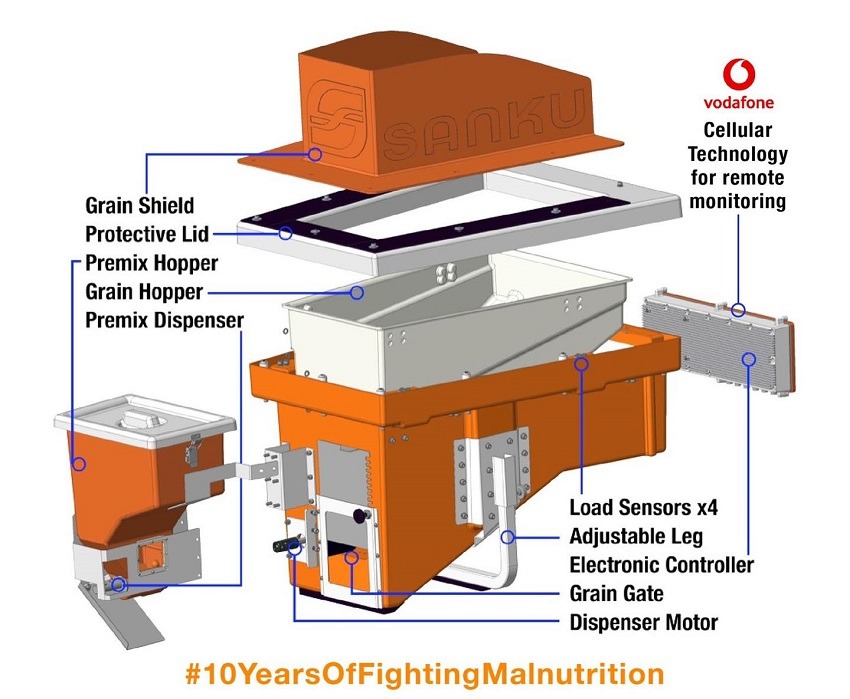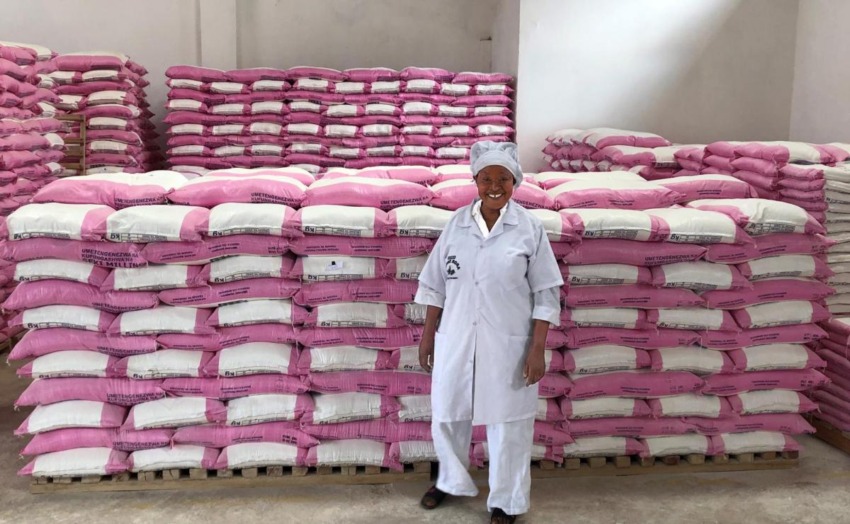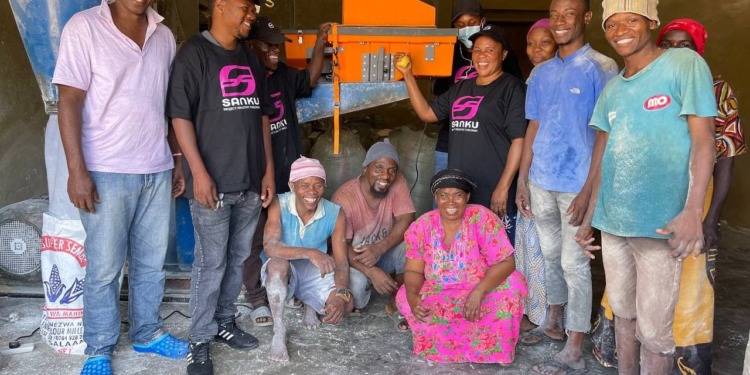28 million children in Sub-Saharan Africa are malnourished. In East Africa, where maize is a staple part of their diet, there is a significant decline in crop varieties as a result of climate change, conflict, agricultural unproductivity, economic decline, and the COVID-19 pandemic. The problem is only getting worse but Sanku could be the solution to this issue. Sanku is the product of Project Healthy Children, an initiative that focused on supporting large-scale fortification initiatives.
David Dodson, one of the co-founders, was driving through rural Rwanda, where Project Healthy Children was implementing a large-scale fortification program. And that was the moment when David realized that the program would never reach the small mills in the local Rwanda villages, those that need no less help than the mills engaged in Project Healthy Children.
David realized that if someone could devise a means and a technology to fortify food in the thousands of small mills scattered across the developing world, they could reach the most vulnerable populations with a cost-effective solution that prevents disease before it happens.
A little less than 2 decades later, Sanku recently celebrated the 10-year anniversary of the first successful Sanku dosifier. It is a milestone for Sanku, they have now installed over 700 dosifiers in rural Africa, feeding a population of over 3 million with nutritious flour.
The Sanku dosifier is a device that injects nutrient premix into flours that are detected to carry weight losses. It is a fully-automatic user-centric approach that ensures the highest efficiency. Every single one of the devices installed is connected to a centralized dashboard through a cellular link, allowing Sanku to monitor the real-time data generated. Sanku can then make sure the dosifiers are functioning correctly and allow their field staff to be notified and respond when a malfunction is detected. Ensuring that Sanku millers always have the tools that they need to fortify their flour is one of Sanku’s main KPIs.
Witnessing success over the past years, Sanku is planning to enter 5-10 more countries by the end of this decade. The organization has developed a list of 10 potential countries for regional expansion that can pose the highest potential for Sanku’s fortification model as micronutrient fortification could significantly improve related health issues like anemia and stunting. Sanku is now working closely with multiple donors to conduct a map of future expansion to prioritize their country expansion and extract a list of high-impact millers to target.
Sanku just won the 2022 Classy Social Innovation Award and we took this opportunity to have a chat with Leah Tronel, Director of Development at Sanku to help us understand better how Sanku works and about the future of the organization. Sanku
It seems that Sanku has its main focus on rural millers of Africa. How does Sanku ensure that the dosifier can work and how does Sanku respond to its malfunctions?
Leah Tronel: When installing a dosifier, we verify that the cellular link is connecting correctly to our systems. Data points generated every 5 minutes are sent in real-time via that cellular link to a centralized dashboard. Information shared allows us to tell whether the dosifier is functioning correctly, dosing accurately and how much fortified flour is being produced.
It also lets us know if a dosifier has been offline for an extended period. Once an issue is signaled, our field staff visit the mill to perform basic repairs or swap with a temporary replacement, if onsite repairs prove impossible. We also visit every mill monthly to check for any issues, perform training and provide support to our millers. Ensuring that our millers always have the tools that they need to fortify their flour is one of our main KPIs.

How confident is Sanku regarding the future of agriculture in Africa and the view that Africa can feed itself? It seems that Sanku’s solution depends on a stable output from the African agricultural sector and agricultural output can differ greatly due to weather conditions and be highly affected by climate change. Where does Sanku stand on this issue?
L.T.: With climate change adversely affecting the nutritional value of many crops, we feel a pressing need to scale our solution to ensure that vulnerable populations can access the nutrients they need through a staple part of their diet.
In the countries where we currently operate (Kenya and Tanzania), the government has systems in place to procure and store raw maize in the event of shortages (e.g. the National Food Reserve Agency (NFRA) in Tanzania). We work hard to build and maintain relationships with these bodies so that, if necessary, we can advocate for the release of raw maize to the millers we work with, ensuring that our reach is not affected.
RELATED ARTICLES: Worst Drought in Forty Years Pushes East Africa to the Brink of Famine | UN Food Systems Summit Ends in Crisis | Reimagining Generational Gaps to Transform Africa’s Agri-food Systems | How Women Are Fighting Drought, Hunger & Inequity
Would you mind sharing with us some details of the expansion plan of Sanku?
L.T.: To date, Sanku has fortified more than one billion meals across East Africa, reaching over 3 million people. We are gearing up for exponential growth and are ready to expand our successful model to other countries in the region.
We have taken the first steps toward serving the Kenyan market by establishing an office in Nairobi, hiring the core team, and building relationships with key stakeholders. In partnership with the World Food Programme’s Innovation Accelerator (funded by the Bill and Melinda Gates Foundation), we plan to run several pilots in Kenya this year before quickly scaling.
Kenya was the logical choice for our expansion given the high rates of malnutrition, the fact that maize flour is a staple part of the Kenyan diet, the proximity to Tanzania (for ease of training and logistics), and the government’s strong support of fortification.
We plan to enter 5-10 additional countries this decade. Based on conversations with stakeholders and publicly available health indicators, Sanku has developed a list of ten potential countries for regional expansion. These countries have the highest impact potential for Sanku’s fortification model, as these are countries where micronutrient fortification could significantly improve related health issues such as stunting and anemia.

Could you also share with us some of your thoughts and feelings regarding the entire project when you see the final result come out and people benefit from it, how do you feel?
L.T.: Before joining Sanku, I worked for a donor who supported cost-effective interventions addressing the main causes of child mortality. We visited every project funded. During a visit to a large-scale wheat fortification project in Tanzania, I learned about the need for small-scale fortification.
Everyone I spoke to – from the government officials we met, the partner we had funded, to the mills who the project had supported – said that fortification was great, but that to be truly impactful, we needed to find a way to work with small maize mills as they feed the people who would most benefit. They also said that many organizations had tried to support fortification at small mills, but they had all failed – it was considered impossible.
A few years later I learned about Sanku and immediately reached out. During my visit as a donor, I was struck by Sanku’s business approach to development and the team’s can-do attitude. When I left, I said to myself that if ever a job became available at Sanku, I would apply and now 3 years later here I am. I am incredibly proud to be part of a team that is making the impossible, possible.
Editor’s Note: The opinions expressed here by Impakter.com columnists are their own, not those of Impakter.com. — In the Featured Photo: A group of millers around a dosifier. Photo Credit: Sanku.










